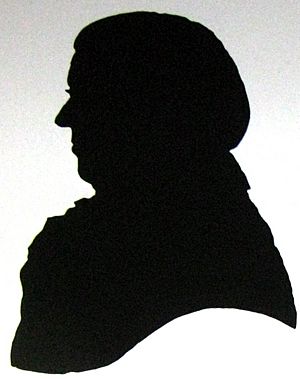John Farey Sr. facts for kids
John Farey Sr. (born September 24, 1766 – died January 6, 1826) was an English geologist and writer. He is most famous for something in math called the Farey sequence, which is named after him.
Contents
About John Farey
His Early Life and Education
John Farey Sr. was born on September 24, 1766, in Woburn, England. He went to school in Halifax, Yorkshire. Even when he was young, John was very good at math, drawing, and surveying land. His talents were noticed by a famous engineer named John Smeaton.
After finishing school, Farey moved to London. There, he met and married Sophia Hubert. They had nine children together, though two sadly died when they were very young. One of his grandchildren, Sophie Gengembre Anderson, became a well-known artist.
Working as a Surveyor and Geologist
In 1792, John Farey became a surveyor and land agent for the Duke of Bedford's estates in Woburn. This meant he helped manage the duke's land. After the duke passed away in 1802, Farey moved back to London. He decided to become a consulting surveyor and geologist.
A big reason he could do this was because he knew a geologist named William Smith. Smith was hired by the Duke of Bedford to study the layers of rock (strata) in the area. Farey went with Smith and learned a lot from him about surveying minerals. Farey often said that Smith was his teacher in this field.
In 1805, Farey became the secretary of the Smithfield Club, a group interested in farming. His work as a surveyor took him all over England. Landowners often asked for his help to improve their estates or find valuable minerals. His knowledge of economic geology (finding useful rocks and minerals) was very important during the Industrial Revolution. This was a time when new sources of coal and metal ores were needed to power factories and machines.
John Farey's Work
His Many Writings
John Farey wrote a lot! He published around 270 papers on many different topics. These included gardening, geology, weather, measurements, money systems, music, and math. He even wrote about being peaceful.
He was a major writer for Rees's Cyclopædia, which was a huge encyclopedia. He wrote long articles about canals, minerals, and surveying. His article on canals was incredibly long, with about 210,000 words! He also wrote for the Edinburgh Encyclopedia.
Farey was also very interested in music. He wrote about 350 articles on music for encyclopedias and other publications. These articles often discussed the mathematical relationships between musical notes and how musical instruments are tuned. He even created a special way to write down sounds using numbers.
In 1809, Farey met William Martin, who had studied fossils in Derbyshire. They wanted to create a geological map of Derbyshire together, but Martin became too ill and passed away the next year.
Farey's most famous work is General View of the Agriculture and Minerals of Derbyshire. This book, published in three parts between 1811 and 1817, was for the Board of Agriculture. In the first part, he described the rock layers in Britain and the coal-rich areas of Derbyshire. In this book, and in another paper, he highlighted how important William Smith's discoveries were in geology.
The Farey Sequence
Even though he was a well-known geologist, John Farey is also famous for something in mathematics called the Farey sequence. He noticed this pattern because of his interest in the math behind sound and music.
John Farey died in London. After his death, his wife offered his collection of geological samples to the British Museum, but they did not accept it. Sadly, his collection was then split up and lost.
See also
 In Spanish: John Farey para niños
In Spanish: John Farey para niños


